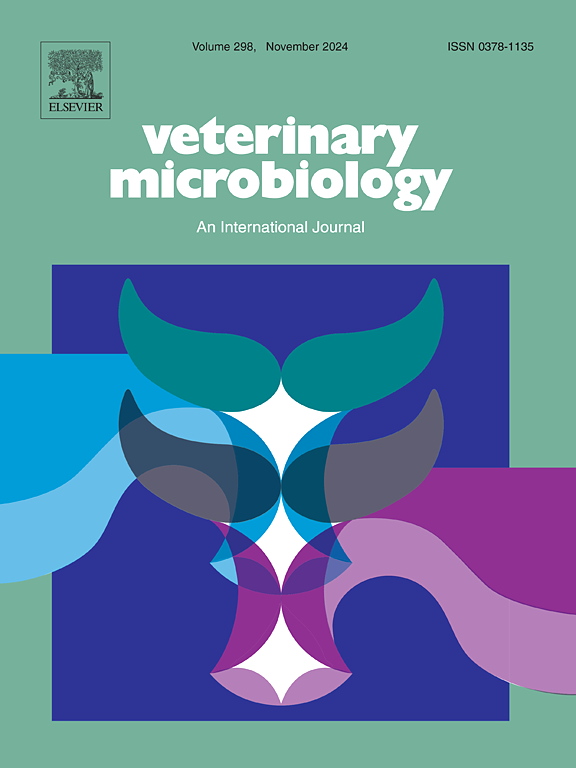Characterization of IS26-bracketed blaCTX-M-65 resistance module on IncI1 and IncX1 plasmids in Escherichia coli ST224 isolated from a chicken in China
IF 2.4
2区 农林科学
Q3 MICROBIOLOGY
引用次数: 0
Abstract
Antimicrobial resistance (AMR) poses a significant global health threat, particularly due to increasing bacterial resistance to β-lactam and aminoglycoside antibiotics, primarily mediated by extended-spectrum β-lactamases (ESBLs) and 16S rRNA methylases in Enterobacteriaceae. In this study, a multidrug resistant (MDR) E. coli strain HN257 isolated from chicken belonging to ST224 and serotype O88:H23 was characterized. SNP-based phylogenetic analysis revealed two distinct clades among poultry-associated E. coli ST224 in this study and others from Genbank, with strain HN257 closely related to chicken-derived E. coli YH17148 (serotype O78:H23), from China. The E. coli HN257 harbored four plasmids with 16 resistance determinants. Two blaCTX-M-65 genes were located on different plasmids with an IS26-bracketed resistance module IS26-traI-fip-∆ISEcp1-blaCTX-M-65-IS903D-iroN-IS26. The plasmid pHN257–2 belonged to the IncI1 ST71 epidemic lineage and carried blaCTX-M-65, blaTEM-1b, rmtB, fosA3, floR, aac(3)-IV and oqxAB, while plasmid pHN257–4 belonged to the non-conjugative IncX1 and carried blaCTX-M-65 and fosA3. Under experimental conditions, a rmtB-positive conjugative helper IncI1 ST136 plasmid could fuse with the non-conjugative pHN257–4 carrying blaCTX-M-65, resulting in the formation of a cointegrate pHN257–F mediated by IS26. Importantly, both single and fused plasmids in transconjugants showed minimal impact on bacterial growth. This study highlights the first identification of a non-conjugative IncX1 plasmid carrying blaCTX-M-65 and fosA3 in MDR E. coli ST224 from poultry, offering critical insights into the presence and transmission dynamics of blaCTX-M-65.
求助全文
约1分钟内获得全文
求助全文
来源期刊

Veterinary microbiology
农林科学-兽医学
CiteScore
5.90
自引率
6.10%
发文量
221
审稿时长
52 days
期刊介绍:
Veterinary Microbiology is concerned with microbial (bacterial, fungal, viral) diseases of domesticated vertebrate animals (livestock, companion animals, fur-bearing animals, game, poultry, fish) that supply food, other useful products or companionship. In addition, Microbial diseases of wild animals living in captivity, or as members of the feral fauna will also be considered if the infections are of interest because of their interrelation with humans (zoonoses) and/or domestic animals. Studies of antimicrobial resistance are also included, provided that the results represent a substantial advance in knowledge. Authors are strongly encouraged to read - prior to submission - the Editorials (''Scope or cope'' and ''Scope or cope II'') published previously in the journal. The Editors reserve the right to suggest submission to another journal for those papers which they feel would be more appropriate for consideration by that journal.
Original research papers of high quality and novelty on aspects of control, host response, molecular biology, pathogenesis, prevention, and treatment of microbial diseases of animals are published. Papers dealing primarily with immunology, epidemiology, molecular biology and antiviral or microbial agents will only be considered if they demonstrate a clear impact on a disease. Papers focusing solely on diagnostic techniques (such as another PCR protocol or ELISA) will not be published - focus should be on a microorganism and not on a particular technique. Papers only reporting microbial sequences, transcriptomics data, or proteomics data will not be considered unless the results represent a substantial advance in knowledge.
Drug trial papers will be considered if they have general application or significance. Papers on the identification of microorganisms will also be considered, but detailed taxonomic studies do not fall within the scope of the journal. Case reports will not be published, unless they have general application or contain novel aspects. Papers of geographically limited interest, which repeat what had been established elsewhere will not be considered. The readership of the journal is global.
 求助内容:
求助内容: 应助结果提醒方式:
应助结果提醒方式:


